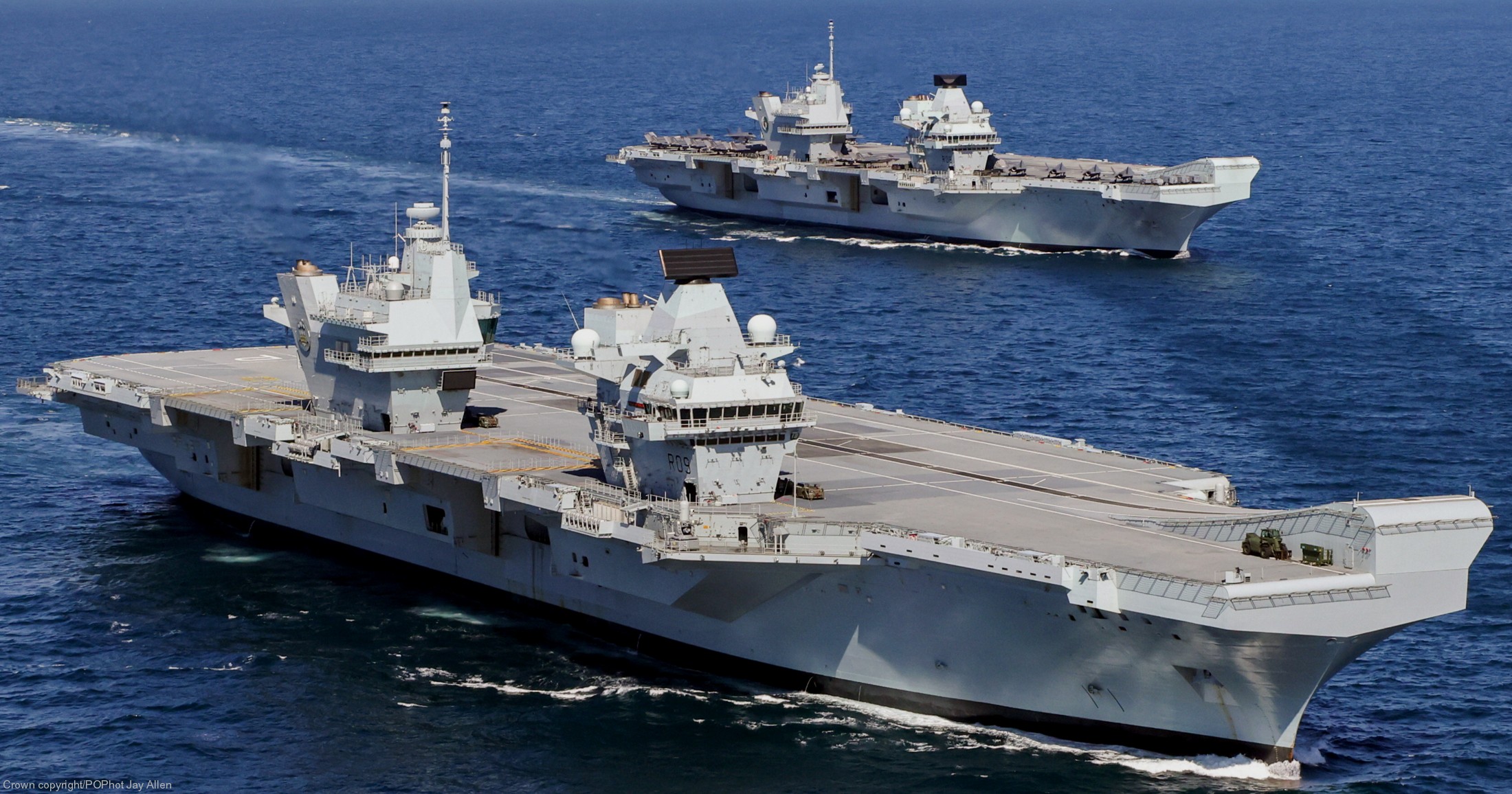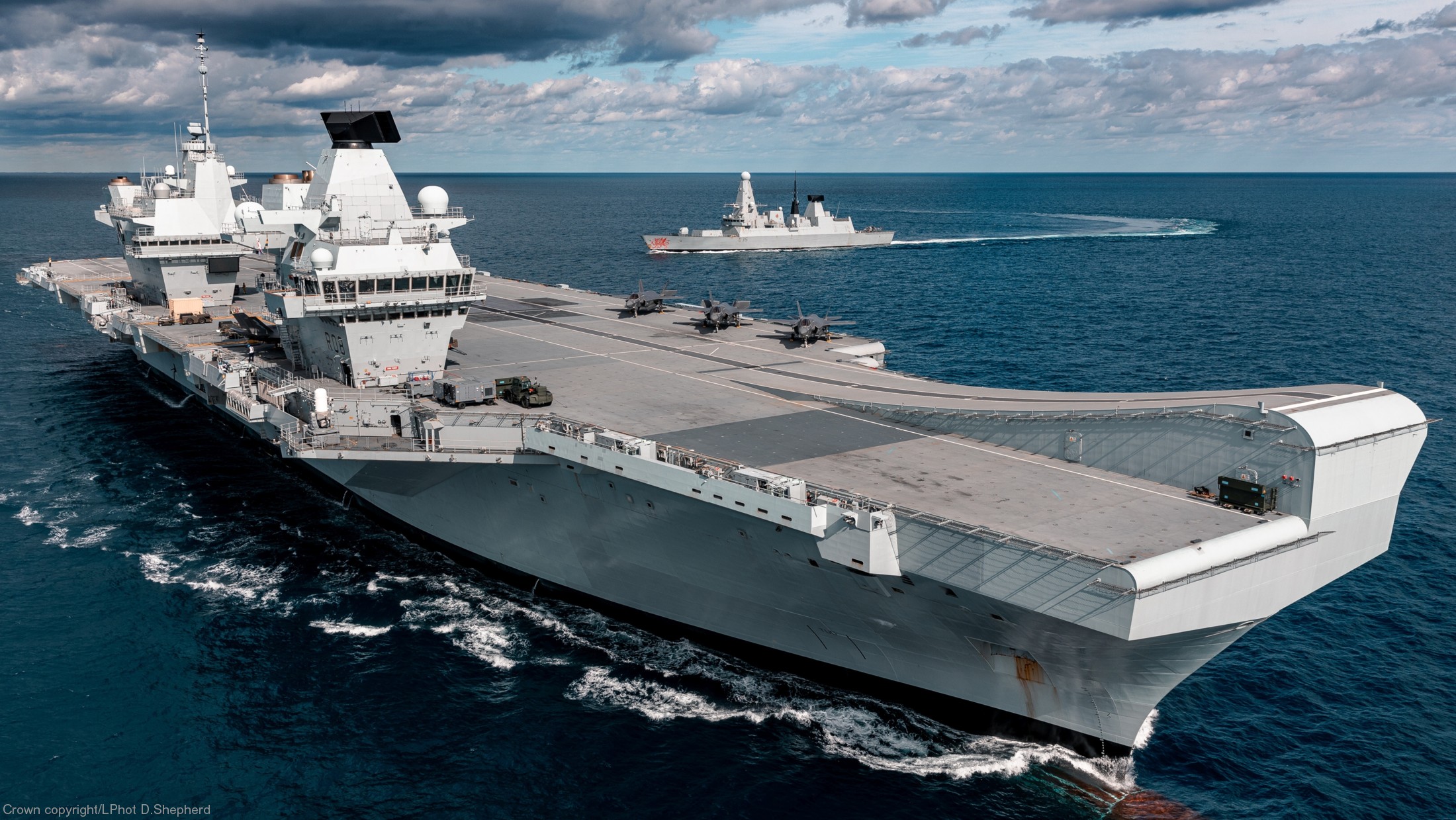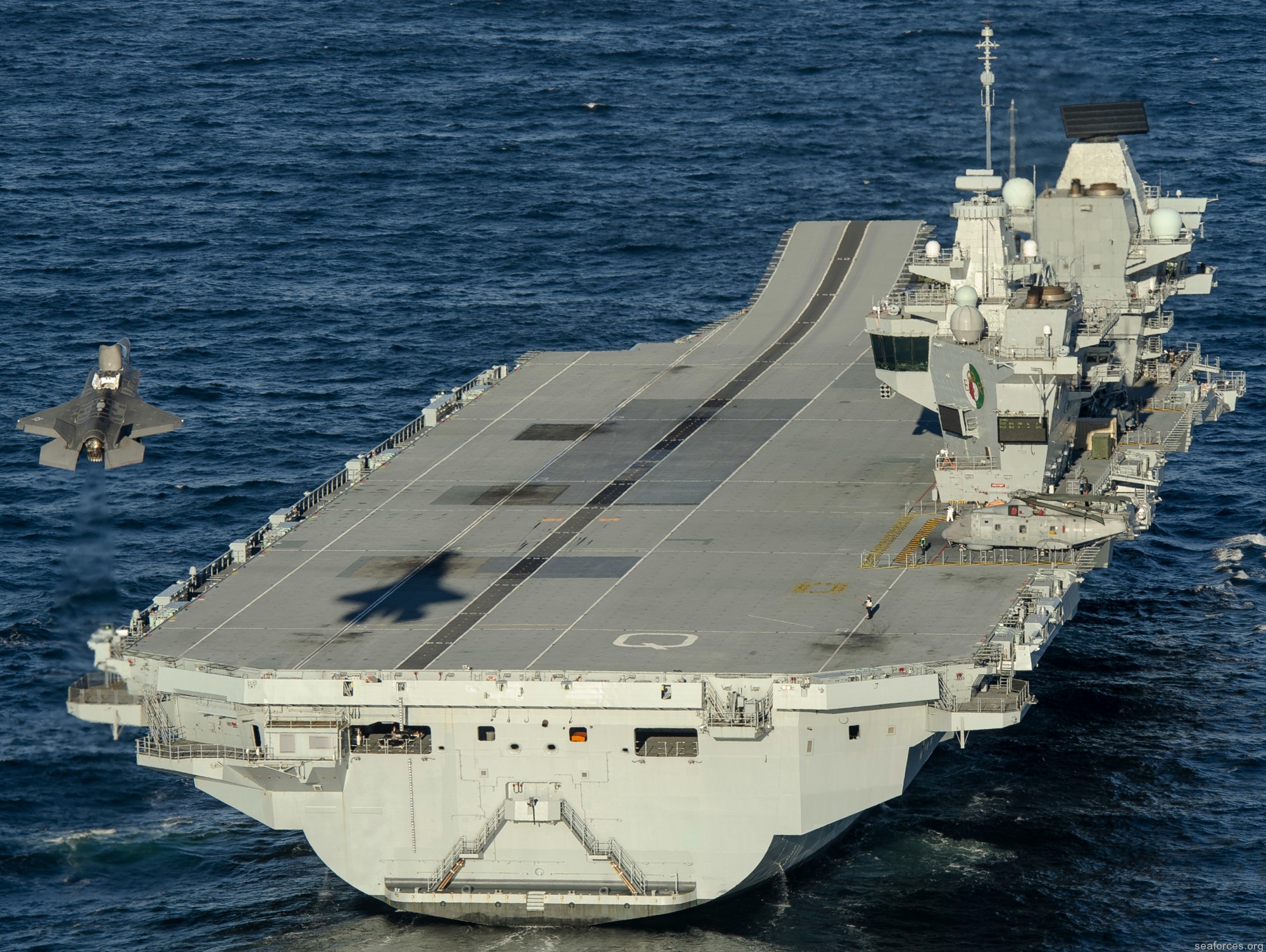|
|
|
HOME
|
US Navy -
ships
|
US Navy - air
units
|
USMC - air
units
|
International
Navies
|
Weapon Systems
|
Special Reports |
|
United Kingdom - Royal Navy Queen Elizabeth class Aircraft Carrier |
 |
| 11/24 |
| Ships: |
|
R 08
HMS Queen Elizabeth R 09 HMS Prince of Wales |
| Specifications: |
|
Length: 280 meters (920 ft) Beam: 73 meters (240 ft) Draft: 11 meters (36 ft) Displacement: 65000 tonnes (full load) Speed: 25+ knots (46+ km/h) Range: 10000 NM (19000 km) Complement: 680 ship crew / 250 to 900 troops / berths for up to 1600 Propulsion: full integrated electric propulsion 4 x Converteam 20MW advanced induction motors 2 x Rolls-Royce Marine Trent MT30 gas turbines (48000 hp / 36 MW) 2 x Wärtsilä 12V38 diesel engines (11700 hp / 8.7 MW) 2 x Wärtsilä 16V38 diesel engines (15600 hp / 11.6 MW) 2 shafts / 2 fixed pitch propellers Armament (defensive): 3 x Mk.15 Phalanx close-in weapon systems (CIWS) 4 x DS30M Mark 2 30mm machine gun systems 6 x M134 Miniguns Aviation: full flight deck with ski jump & hangar for up to 40 aircraft F-35B Lightning II / Merlin HM2, Merlin HC4, Merlin AsAC / Wildcat AH1 and HMA2 / Chinook / Apache AH64 Systems: S1850M long range radar Type 997 Artisan 3D medium range radar Ultra Electronics Series 2500 Electro-Optical System (EOS) Glide Path Camera (GPC) |
|
The Queen Elizabeth class is a class of two aircraft carriers of the
United Kingdom's Royal Navy which are the central components of the
UK Carrier Strike Group. The lead ship, HMS Queen Elizabeth, was
named on 4 July 2014, in honour of Elizabeth I. She was commissioned
on 7 December 2017. The second, HMS Prince of Wales, was launched on
21 December 2017, and was commissioned on 10 December 2019. The contract for the vessels was announced in July 2007, ending several years of delay over cost issues and British naval shipbuilding restructuring. The contracts were signed one year later on 3 July 2008, with the Aircraft Carrier Alliance, a partnership formed with Babcock International, Thales Group, A&P Group, the UK Ministry of Defence and BAE Systems. In 2014 the UK Government announced that the second carrier would be brought into service, ending years of uncertainty surrounding its future. This was confirmed by the Strategic Defence and Security Review 2015, with at least one carrier being available at any time. The vessels have displacement of approximately 65,000 tonnes (64,000 long tons; 72,000 short tons), are 284 metres (932 ft) long and are the largest warships ever constructed for the Royal Navy. The Carrier Air Wing (CVW) will vary depending on the type and location of deployment, but will consist of a maximum of 24 F-35Bs under normal circumstances (or 36 in extreme cases) and Merlin helicopters in both utility and Airborne Early Warning roles. The projected cost of the programme is £6.2 billion. General characteristics The ships' company is 679, rising to 1,600 when the air crew is added. In April 2015 a parliamentary reply stated that the average crew size would be 672. The ships have a displacement of 65,000 tonnes on delivery, but the design allows for this to reach over 70,000 tonnes as the ships are upgraded through their lifetime. They have an overall length of 280 metres (920 ft), a width at deck level of 70 metres (230 ft), a height of 56 metres (184 ft), a draught of 11 metres (36 ft), and a range of 10,000 nautical miles (12,000 mi; 19,000 km). Nuclear propulsion was rejected due to its high cost and manpower required in favour of Integrated Electric Propulsion consisting of two Rolls-Royce Marine Trent MT30 36 MW (48,000 hp) gas turbine generator units and four Wärtsilä diesel generator sets (two 9 MW or 12,000 hp and two 11 MW or 15,000 hp). The Trents and diesels are the largest ever supplied to the Royal Navy, and together they feed the low-voltage electrical systems as well as four GE Power Conversion's 20 MW electric propulsion motors that drive the twin fixed-pitch propellers. Instead of a single island superstructure containing both the ships' navigation bridges and flying control (flyco) centres, the ships have these operations divided between two structures, with the forward island for navigation and the aft island for controlling flying operations. The primary reason for having twin islands was to space out the funnels, as the ships were designed with redundancy with "duplicated main and secondary machinery in two complexes with independent uptakes and downtakes in each of the two islands", while the alternative of consolidating all the exhaust trunkings would have reduced hangar space as well as increasing the vulnerability to flooding. Additional benefits include easier construction, reduced wind turbulence, and freed up deck space. Using two structures provides separate mountings for the air surveillance radar (forward), which does not interfere with the medium-range radar (aft); furthermore, visibility is improved for both navigation and landing operations. Under the flight deck are a further nine decks. The hangar deck measures 155 by 33.5 metres (509 by 110 ft) with a height of 6.7 to 10 metres (22 to 33 ft), large enough to accommodate up to twenty fixed and rotary wing aircraft. To transfer aircraft from the hangar to the flight deck, the ships have two large lifts, each of which is capable of lifting two F-35-sized aircraft, or one CH-47 Chinook from the hangar to the flight deck in sixty seconds. The ships' only announced self-defence weapons are currently the Phalanx CIWS for airborne threats, with miniguns and 30 mm cannon to counter seaborne threats, which are fitted for but not with, and not carried as of 2021. Systems The ship's radars will be the BAE Systems/Thales S1850M for long-range wide-area search, the BAE Systems Artisan 3D Type 997 maritime medium-range active electronically scanned array radar, and a navigation radar. BAE claims the S1850M has a fully automatic detection and track initiation that can track up to 1,000 air targets at a range of around 400 kilometres (250 mi). Artisan can "track a target the size of a snooker ball over 20 kilometres (12 mi) away", with a maximum range of 200 km. They will also be fitted with the Ultra Electronics Series 2500 Electro Optical System (EOS) and Glide Path Camera (GPC). Munitions and ammunition handling is accomplished using a Babcock designed highly mechanised weapons handling system (HMWHS). This is the first naval application of a common land-based warehouse system. The HMWHS moves palletised munitions from the magazines and weapon preparation areas, along trackways and via several lifts, forward and aft or port and starboard. The tracks can carry a pallet to magazines, the hangar, weapons preparation areas, and the flight deck. In a change from normal procedures the magazines are unmanned, the movement of pallets is controlled from a central location, and manpower is only required when munitions are being initially stored or prepared for use. This system speeds up delivery and reduces the size of the crew by automation. Crew facilities Crew facilities include a cinema, five physical fitness areas (gyms), a chapel (with embarked naval chaplain), and four galleys manned by sixty-seven catering staff. There are four large dining areas, the largest with the capacity to serve 960 meals in one hour. There are eleven medical staff for the eight-bed medical facility, which includes an operating theatre and a dental surgery. There are 1,600 bunks in 470 cabins, including accommodation for a company of 250 Royal Marines with wide access routes up to the flight deck. Carrier air group A maximum of 24 F-35Bs will operate from each carrier under normal circumstances, with the ability to operate 36 in extreme circumstances. The ships have a sortie generation rate of up to 110 per day. Fourteen Merlin HM2 will be available with typically nine in anti-submarine configuration and four or five with Merlin ASaC Crowsnest for airborne early warning; alternatively a "littoral manoeuvre" package could include a mix of Royal Navy Commando Helicopter Force Merlin HC4, Wildcat AH1, RAF Chinook transports, and Army Air Corps Apache attack helicopters. As of September 2013 six landing spots are planned, but the deck could be marked out for the operation of ten medium helicopters at once, allowing the lift of a company of 250 troops. The hangars are designed for operating Chinooks without blade folding and the Bell Boeing V-22 Osprey tiltrotor; the two aircraft lifts can each accommodate a Chinook with unfolded blades. As the Royal Navy plans to operate the aircraft carriers in rotation, it will only form a single carrier air group to equip whichever aircraft carrier is deployed. However, drones may allow the opportunity for the Royal Navy to form a second carrier air group. Construction: The building was undertaken by four companies across seven shipyards, with final block integration and assembly at Rosyth: BAE Systems Surface Ships - Govan (Lower Blocks 3 and 4), Scotstoun (aft island) and Portsmouth (Lower Blocks 2, 5 and forward island) Babcock Marine - Rosyth (Sponsons, Mast and Centre Blocks 5 and 6) and Appledore (Lower Block 1) A&P Group - Hebburn (Centre Block 3) Cammell Laird - Birkenhead (Centre Blocks 2 and 4) The construction of the two carriers involves more than 10,000 people from 90 companies, 7,000 of them in the six shipyards building the sections of the ships. source: wikipedia |
|
class + detail images for more images go to the individual ship-site |
                 |
|
|
seaforces.org
|
Royal
Navy start page
| |
